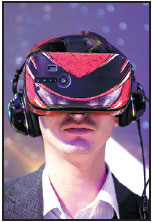Wearables seek permanent place
By Agence France-presse (China Daily) Updated: 2017-03-02 07:26Tech companies turn their focus as sales of smartphones slowing
BARCELONA - Consumers are snapping up fitness trackers, smartwatches and other connected wearable gadgets - but huge numbers wind up in drawers unused after just a few months once the novelty wears off.
"Abandonment has been a big problem with wearable products," said Mike Pedler, the leader of PwC's product innovation and development practice.
"It is something that everyone involved in designing and producing wearables is still wrestling to address."
With worldwide sales of smartphones now barely growing, many tech firms have turned their focus to wearable gadgets in the hope that they will be the next big source of growth.
Chinese telecom giant Huawei Technologies, the world's third-largest phone maker, unveiled a new smartwatch at the Mobile World Congress with a more sporty look than the first device it released two years ago.
Dozens of other wearable gadgets, ranging from bracelets that measure your heart rate to GPS-connected footwear, were on show at the event which wrapped up on Thursday.
CCS Insight predicts 411 million wearables devices - including virtual reality headsets and wearable cameras - will be sold around the world in 2020, up from 123 million in 2016.
But about a third of owners of smart wearables abandon these devices after six months, according consulting firm Endeavour Partners.
'Lack killer app'
Part of the problem is that smartphones can already do most of the things people use wearables for - they act as pedometers, count calories, measure heartbeats and make payments.
"Wearables lack a killer application," said Pedler.
Wearables also often need to work together with a smartphone, leading consumers to complain that they are a hassle to use.
The main reasons people gave for abandoning their fitness wearables was that they were "too difficult" or "are annoying", a 2016 study said.
Huawei's new watch has its own cellular connection and the chief executive of the company's consumer business group, Richard Yu, said this is the key to increase the appeal of smartwatches.
"Most smartwatches do not have an autonomous internet connection, you need your smartphone nearby and that uses a lot of energy, that has hindered the development of the market," he said.
'Need better design'
The look of wearables is also an issue. Huge batteries make them big and bulky.
"We need to see better design," said Ramon Llamas, manager of IDC's wearables team.
"The wearables we have seen have really been first generation type devices", he said, adding that he hopes for improvements.
Researchers are working with flexible materials like graphene - which is 100 times stronger than steel, super thin and can conduct electricity and heat - to make more attractive wearables.
Barcelona's Institute of Photonic Sciences has made a prototype of a graphene wearable device which it displayed at the fair that can wrap around a wrist measuring heart rate and oxygen levels.
Graphene will allow firms to focus on the design of wearables instead of focusing just on the technology, said Frank Koppens, a graphene specialist at the institute.
"You won't even notice it is a wearable," he added.
|
|
- 'Cooperation is complementary'
- Worldwide manhunt nets 50th fugitive
- China-Japan meet seeks cooperation
- Agency ensuring natural gas supply
- Global manhunt sees China catch its 50th fugitive
- Call for 'Red Boat Spirit' a noble goal, official says
- China 'open to world' of foreign talent
- Free trade studies agreed on as Li meets with Canadian PM Trudeau
- Emojis on austerity rules from top anti-graft authority go viral
- Xi: All aboard internet express












